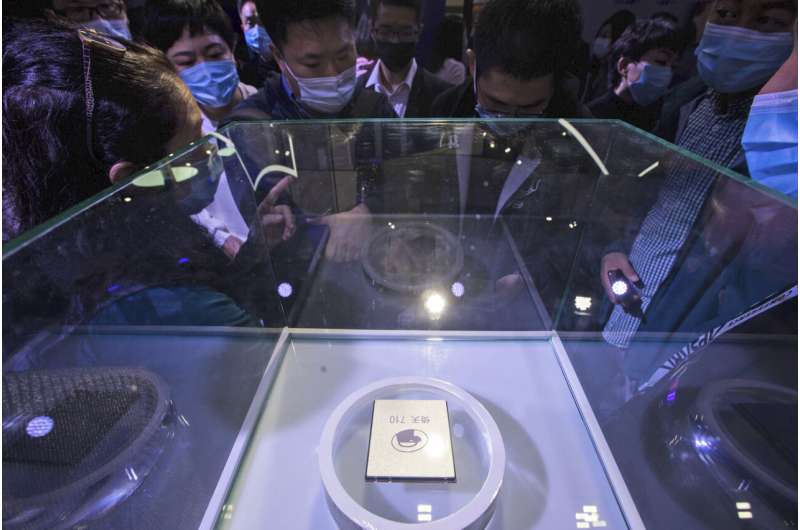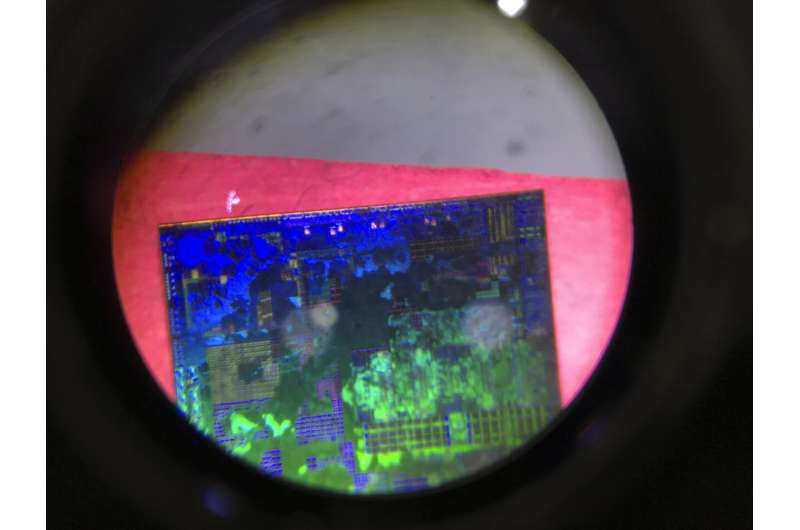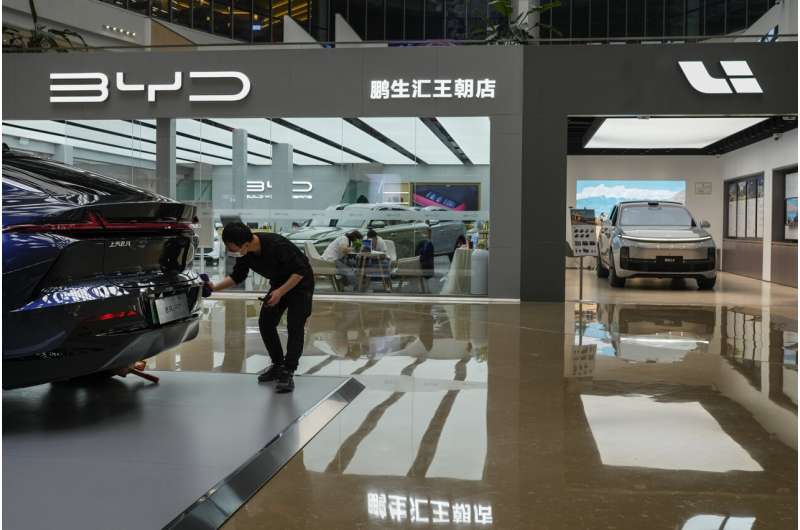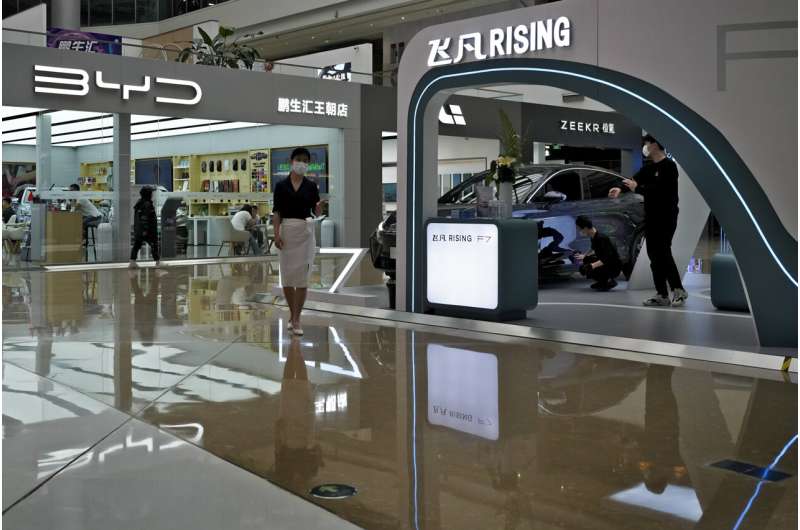China seethes as US chip controls threaten tech ambitions

Furious at U.S. efforts that cut off access to technology to make advanced computer chips, China’s leaders appear to be struggling to figure out how to retaliate without hurting their own ambitions in telecoms, artificial intelligence and other industries.
President Xi Jinping’s government sees the chips that are used in everything from phones to kitchen appliances to fighter jets as crucial assets in its strategic rivalry with Washington and efforts to gain wealth and global influence. Chips are the center of a “technology war,” a Chinese scientist wrote in an official journal in February.
China has its own chip foundries, but they supply only low-end processors used in autos and appliances. The U.S. government, starting under then-President Donald Trump, is cutting off access to a growing array of tools to make chips for computer servers, AI and other advanced applications. Japan and the Netherlands have joined in limiting access to technology they say might be used to make weapons.
Xi, in unusually pointed language, accused Washington in March of trying to block China’s development with a campaign of “containment and suppression.” He called on the public to “dare to fight.”
Despite that, Beijing has been slow to retaliate against U.S. companies, possibly to avoid disrupting Chinese industries that assemble most of the world’s smartphones, tablet computers and other consumer electronics. They import more than $300 billion worth of foreign chips every year.
The ruling Communist Party is throwing billions of dollars at trying to accelerate chip development and reduce the need for foreign technology.
China’s loudest complaint: It is blocked from buying a machine available only from a Dutch company, ASML, that uses ultraviolet light to etch circuits into silicon chips on a scale measured in nanometers, or billionths of a meter. Without that, Chinese efforts to make transistors faster and more efficient by packing them more closely together on fingernail-size slivers of silicon are stalled.
Making processor chips requires some 1,500 steps and technologies owned by U.S., European, Japanese and other suppliers.

“China won’t swallow everything. If damage occurs, we must take action to protect ourselves,” the Chinese ambassador to the Netherlands, Tan Jian, told the Dutch newspaper Financieele Dagblad.
“I’m not going to speculate on what that might be,” Tan said. “It won’t just be harsh words.”
The conflict has prompted warnings the world might decouple, or split into separate spheres with incompatible technology standards that mean computers, smartphones and other products from one region wouldn’t work in others. That would raise costs and might slow innovation.
“The bifurcation in technological and economic systems is deepening,” Prime Minister Lee Hsien Loong of Singapore said at an economic forum in China last month. “This will impose a huge economic cost.”
U.S.-Chinese relations are at their lowest level in decades due to disputes over security, Beijing’s treatment of Hong Kong and Muslim ethnic minorities, territorial disputes and China’s multibillion-dollar trade surpluses.
Chinese industries will “hit a wall” in 2025 or 2026 if they can’t get next generation chips or the tools to make their own, said Handel Jones, a tech industry consultant.
China “will start falling behind significantly,” said Jones, CEO of International Business Strategies.
Beijing might have leverage, though, as the biggest source of batteries for electric vehicles, Jones said.

Chinese battery giant CATL supplies U.S. and Europe automakers. Ford Motor Co. plans to use CATL technology in a $3.5 billion battery factory in Michigan.
“China will strike back,” Jones said. “What the public might see is China not giving the U.S. batteries for EVs.”
On Friday, Japan increased pressure on Beijing by joining Washington in imposing controls on exports of chipmaking equipment. The announcement didn’t mention China, but the trade minister said Tokyo doesn’t want its technology used for military purposes.
A Chinese foreign ministry spokeswoman, Mao Ning, warned Japan that “weaponizing sci-tech and trade issues” would “hurt others as well as oneself.”
Hours later, the Chinese government announced an investigation of the biggest U.S. memory chip maker, Micron Technology Inc., a key supplier to Chinese factories. The Cyberspace Administration of China said it would look for national security threats in Micron’s technology and manufacturing but gave no details.
The Chinese military also needs semiconductors for its development of stealth fighter jets, cruise missiles and other weapons.
Chinese alarm grew after President Joe Biden in October expanded controls imposed by Trump on chip manufacturing technology. Biden also barred Americans from helping Chinese manufacturers with some processes.
To nurture Chinese suppliers, Xi’s government is stepping up support that industry experts say already amounts to as much as $30 billion a year in research grants and other subsidies.

China’s biggest maker of memory chips, Yangtze Memory Technologies Corp., or YMTC, received a 49 billion yuan ($7 billion) infusion this year from two official funds, according to Tianyancha, a financial information provider.
One was the government’s main investment vehicle, the China National Integrated Circuit Industry Investment Fund, known as the Big Fund. It was founded in 2014 with 139 billion yuan ($21 billion) and has invested in hundreds of companies.
The Big Fund launched a second entity, known as the Big Fund II, in 2019 with 200 billion yuan ($30 billion).
In January, chip manufacturer Hua Hong Semiconductor said Big Fund II would contribute 1.2 billion yuan ($175 million) for a planned 6.7 billion yuan ($975 million) wafer fabrication facility in eastern China’s Wuxi.
In March, the Cabinet promised tax breaks and other support for the industry. It gave no price tag. The government also has set up “integrated circuit talent training bases” at 23 universities and six at other schools.
“Semiconductors are the ‘main battlefield’ of the current China-U.S. technology war,” Junwei Luo, a scientist at the official Institute of Semiconductors, wrote in the February issue of the journal of the Chinese Academy of Sciences. Luo called for “self-reliance and self-improvement in semiconductors.”
The scale of spending required is huge. The global industry leader, Taiwan Semiconductor Manufacturing Corp., or TSMC, is in the third year of a three-year, $100 billion plan to expand research and production.
Developers including Huawei Technologies Ltd. and VeriSilicon Holdings Co. can design logic chips for smartphones as powerful as those from Intel Corp., Apple Inc., South Korea’s Samsung Electronics Co. or Britain’s Arm Ltd., according to industry researchers. But they cannot be manufactured without the precision technology of TSMC and other foreign foundries.

Trump in 2019 crippled Huawei’s smartphone brand by blocking it from buying U.S. chips or other technology. American officials say Huawei, China’s first global tech brand, might facilitate Chinese spying, an accusation the company denies. In 2020, the White House tightened controls, blocking TSMC and others from using U.S. technology to produce chips for Huawei.
Washington threw up new hurdles for Chinese chip designers in August by imposing restrictions on software known as EDA, or electronic design automation, along with European, Asian and other governments to limit the spread of “dual use” technologies that might be used to make weapons.
In December, Biden added YMTC, the memory chip maker, and some other Chinese companies to a blacklist that limits access to chips made anywhere using U.S. tools or processes.
China’s foundries can etch circuits as small as 28 nanometers apart. By contrast, TSMC and other global competitors can etch circuits just three nanometers apart, ten times the Chinese industry’s precision. They are moving toward two nanometers.
To make the latest chips, “you need EUV (extreme ultraviolet lithography) tools, a very complicated process recipe and not just a couple of billion dollars but tens and tens of billions of dollars,” said Peter Hanbury, who follows the industry for Bain & Co.
“They’re not going to be able to produce competitive server, PC and smartphone chips,” Hanbury said. “You have to go to TSMC to do that.”
China’s ruling party is trying to develop its own tool vendors, but researchers say it is far behind a global network spread across dozens of countries.
Huawei said in a video on its website in December it was working on EUV technology. But creating a machine comparable to ASML’s might cost $5 billion and require a decade of research, according to industry experts. Huawei didn’t respond to a request for comment.
The day when China can supply its own EUV machine is “very far away,” said Hanbury.
© 2023 The Associated Press. All rights reserved. This material may not be published, broadcast, rewritten or redistributed without permission.
Citation:
China seethes as US chip controls threaten tech ambitions (2023, April 4)
retrieved 4 April 2023
from https://techxplore.com/news/2023-04-china-seethes-chip-threaten-tech.html
This document is subject to copyright. Apart from any fair dealing for the purpose of private study or research, no
part may be reproduced without the written permission. The content is provided for information purposes only.
For all the latest Technology News Click Here
For the latest news and updates, follow us on Google News.

